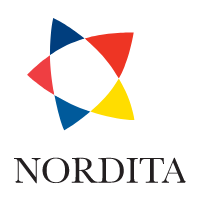33rd Nordic Network Meeting on "Strings, Fields and Branes"
Albano 2: C2207 - Auditorium 4 (80 seats)
Albano Building 2
Venue
Nordita, Stockholm, Sweden
Zoom link:
https://eu01web.zoom.us/j/9437491344?pwd=ZTQyWHFENjR4ZlBReWtBdG0yWlpoQT09&omn=66829800888
Scope
The Nordic Meetings on "Strings, Fields and Branes" started as informal meetings around 1994-1995 and have since been hosted in turn by various institutes in the Nordic countries. This series of meetings is intended to especially provide opportunities for (PhD) students and early postdoc researchers in High Energy Theory physics and related topics working within the Nordic community to interact, exchange ideas, and give presentations. The meeting also aims to put students and junior researchers in contact with the forefront of current research in the field, through a series of pedagogical lectures by leading experts on topics of significant recent interest. More senior people are also warmly invited to attend!
Preliminary programme schedule
This year we organize the meeting starting from 12:55 on Tuesday 29 October 2024 until 14:30 on Thursday 31 October. The conference dinner is scheduled on the evening of Wednesday 30 October. The programme will consist of three longer talks and shorter talks about exciting new research. You can register to give a short talk. In addition there will be two 'career' talks by speakers with a HEPTH background.
BONUS:
On Thursday at 15:30 there is the opportunity to attend the Oskar Klein Lecture, a separate event, given by Renata Kallosh.
Invited speakers
Long talks:
- Bo Sundborg (Stockholm University)
- Nele Callebaut (Cologne University)
- Pietro Longhi (Uppsala University)
Career talks:
- David Marsh (Stockholm University)
- Marjorie Schillo (EliseAI)
Regular talks:
- Alexia Nix (University of Iceland)
- Andrea Sangiovanni (Uppsala University)
- Anton Nedelin (King's College London)
- Emil Have (Niels Bohr Institute)
- Evangelos Tsolakidis (University of Iceland)
- Ingrid Vazquez-Holm (Uppsala University and Nordita)
- Istvan Mate Szecsenyi (U. of Modena and Reggie Emilia)
- Marcus Sperling (University of Vienna)
- Martin Cederwall (Chalmers)
- Matthias Harksen (University of Iceland)
- Max Huebner (Uppsala)
- Niels Obers (Niels Bohr Institute and Nordita)
- Oscar Henriksson (Åbo Akademi University)
- Roman Mauch (Uppsala University)
- Shani Nadir Meynet (Uppsala University)
- Troels Harmark (Niels Bohr Institute)
- Victor Mishnyakov (Nordita)
- Vincent Van Hemelryck (Uppsala University)
- Vyshnav Mohan (University of Iceland)
- William Lindved (University of Edinburgh)
Accommodation
Nordita has reserved a block of rooms at the following hotels:
-
Elite Hotel Arcadia | 10 rooms for single or double use - For details and reserving a room, click here. Last day to book your room is 30th of September.
-
Biz Apartment Gärdet | 15 Studio small (single-use) - For reserving a room, contact at reservations@bizapartment.se. You can inform the hotel that you are making a reservation for the workshop by referring the code SFB. Last day to book your room is 30th of September.
Nightly rate for studio small - 1295 SEK/night incl. breakfast
-
All reservations, payments, date adjustments and/or cancellations are to be made by the interested participant directly with the hotels.
Please be aware that scammers sometimes approach participants claiming to be able to provide accommodation and asking for credit card details. Do not give this information to them! If you are in any doubt about the legitimacy of an approach, please get in contact with the organizers.
Financial support
Unfortunately, we will not be able to provide financial support towards travel or accommodation. However, lunches, coffee breaks and the dinner on Wednesday are complementary.
Application/Registration
We have two deadlines. The first deadline is 8 September 2024, for those who also want to be considered to give a talk. The second deadline is 30 September 2024, for those who just want to attend. Digital attendance is possible. Due to venue restrictions we will prioritize people with Nordic affiliations (Groningen included).
History
The Nordic Meetings on "Strings, Fields and Branes" (originally called Nordic meetings on "Supersymmetric Field and String Theories") started as informal meetings around 1994-1995 and have since been hosted in turn by various institutes in the Nordic countries.
An incomplete list of the previous meetings is as follows:
| Meeting # | Location | Dates |
| 1 | Copenhagen | 30/8-4/9/1993 |
| 2 | Stockholm/Copenhagen? | 1994/1995? |
| 3 | Stockholm | 6-8/5/1996 |
| 4 | Gothenburg | 9-11/9/1996 |
| 5 | Helsinki | 10-12/3/1997 |
| 6 | ? | |
| 7 | Uppsala | 24-26/11/1997 |
| 8 | Stockholm | 9-12/3/1998 |
| 9 | Gothenburg | 17-19/8/1998 |
| 10 | Helsinki | 2-4/12/1999 |
| 11 | Copenhagen | 4-6/5/2000 |
| 12 | Gothenburg | 16-18/11/2000 |
| 13 | Uppsala | 3-5/5/2001 |
| 14 | Stockholm | 15-17/11/2001 |
| 15 | Karlstad | 9-11/5/2002 |
| 16 | Copenhagen | 28-30/11/2002 |
| 17 | Oslo | 8-10/5/2003 |
| 18 | Groningen | 13-15/5/2004 |
| 19 | Uppsala | 18-20/11/2004 |
| 20 | Helsinki | 27-28/10/2005 |
| 21 | Stockholm | 15-17/2/2007 |
| 22 | Stockholm | 27-29/11/2008 |
| 23 | Copenhagen | 16-18/4/2009 |
| 24 | Groningen | 3-5/12/2009 |
| 25 | Stockholm | 25-27/3/2010 |
| 26 | Gothenburg | 21-23/10/2010 |
| 27 | Copenhagen | 24-26/3/2011 |
| 28 | Stockholm | 1-3/12/2011 |
| 29 | Nordita | 7-9/11/2013 |
| 30 | Nordita | 22-24/11/2021 |
| 31 | Copenhagen | 14-16/11/2022 |
| 32 | Stavanger | 4-6/12/2023 |
| 33 | Nordita | 29-31/10/2024 |

